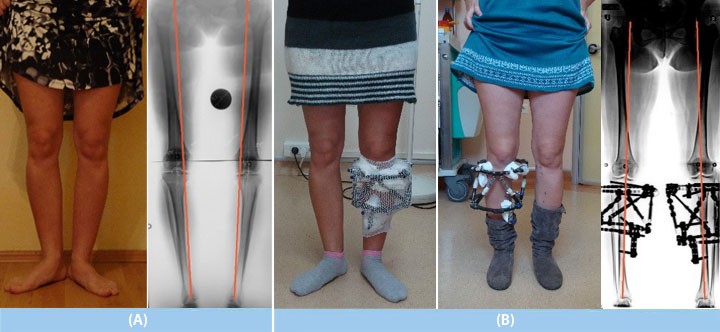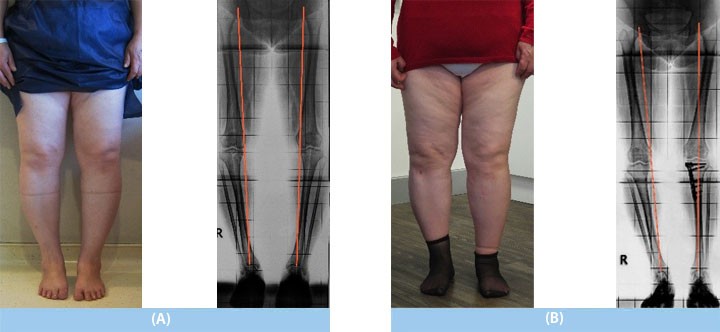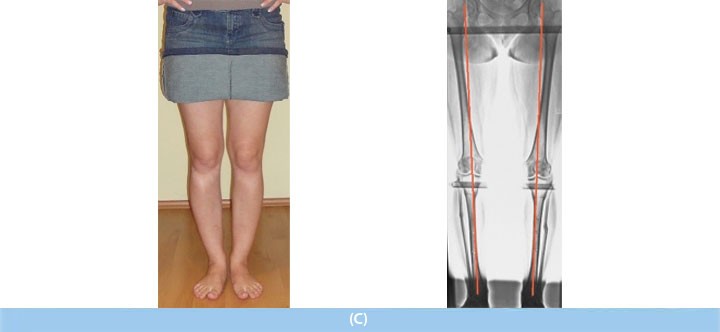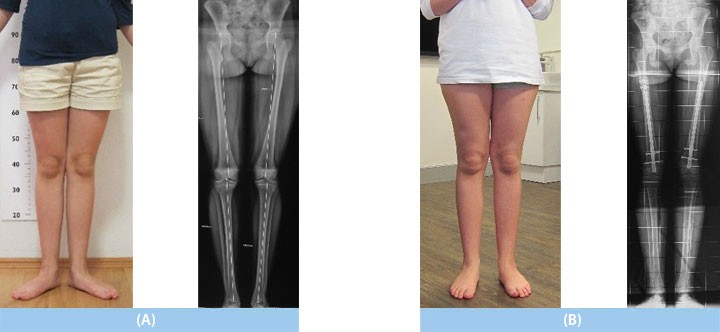How is knock-knee treated in adults?
Knock-knee in Adults
In adults, we understand knock-knee to mean a deformity occurring without any known illness in the knee. Besides cosmetic concerns, those who have these deformities usually express no other complaints. In young ages they are able to do sports activities and experience no type of restrictions in their lives; however, they worry about the appearance of the deformity. Generally among older members of the family, on the mother or father's side, there can be a history of arthritis of the knee and related surgery.
Left untreated, the patient will complain about arthritis in the knee around age 65 and will require a knee prosthesis. If the person is active in sports, meniscus tears at an early age can lead to ligament injuries. These additional problems increase the risk of arthritis in the knee in later years. The treatment of leg deformities in young patients is much less risky than performing knee prosthetic surgery on patients in later years to treat arthritis.
Correcting these deformities at a young age before arthritis develops reduces the possibility of bigger surgeries at a later age.
How is it treated?
Knock-knee can be assessed in two separate age groups. The first group is young active patients; arthritis has not developed yet in these patients, and there are usually only aesthetic concerns. The second group represents older patients (over age 50); depending on how far the arthritis has developed in the patient, pain, cracking or popping sounds coming from the knee, swelling and joint stiffness can be seen.
A decision about the most appropriate treatment is made after X-rays are taken and a clinical examination is performed. The "Tomofix method" is one of the most widely used methods in the world (For additional information on issues related to leg discrepancies and deformities, see "Leg Length Discrepancy and Limb Deformities in Adults" section).
In the first group, young active patients, the deformity in the knees is brought within the normal limits. In other words, a correction is made so that the line called the "mechanical axis" (the line which passes through the center of the body—red line) is brought to the center of the knee joint (Case 1).
In the second group, older patients, an adjustment is made so that the "mechanical axis" passes through the outer part of the knee joint which carries the weight and is more stable (arthritis has not developed) (Case 2).
If there is a torsional deformity, our knees and feet turn in different directions while walking. Torsional deformities can be corrected using various techniques, depending on the amount as well as the location of the deformities (Cases 3,4).
Case 1
A) Due to vitamin D-resistant rickets, which is a metabolic bone disease, curvature developed in both legs during growth (age 16).
B) The Taylor Spatial Frame (computer-assisted external fixator) was used to perform a lengthening of the tibia and the femur, which involved using a minimally invasive locking plate technique to assist the external fixator.
C) The patient had had difficulty walking before but was able to enjoy sports activities with no restrictions following the treatment.
Case 2

A) She complained about pain and arthritis in the knee joint (age 60). Arthrosis was detected in the knee joint due to the bone deformity. Because the arthrosis was in the early stages, correction therapy was preferred over knee replacement surgery. In both knees, the "mechanical axis” (the line which passes through the center of the body—red line) which should normally pass through the center of the knees, was passing through the interior of the knee joint.
B) The "Tomofix method" was used to treat the left leg curvature. After the treatment, the “mechanical axis” had completely shifted to the left. In the 6th week after surgery, she began to put all her weight on the leg. The knee pain was completely gone, and the progression of arthritis had stopped as well. Also, the patient was quite happy with the results.
Case 3 Torsional Deformity


A) Bone deformities can sometimes be torsional in nature. Due to the torsional curvature of the leg, the knees were turning to both sides while walking, running was difficult, and the patient was not satisfied with the look of the knees (age 28). She had also undergone arthroscopic surgery due to a meniscus injury caused by repeated knee sprains.
B) The Taylor Spatial Frame (computer-assisted external fixator) method was used to correct the curvature and torsional deformity. The degree of correction was calculated using the “CT method” (Calculating the Mounting Parameters for Taylor Spatial Frame Correction Using Computed Tomography. Metin Kucukkaya et al., J Orthop Trauma, 2011).
C) The treatment lasted 4 months, and after treatment she returned to daily life. The issues with the knees completely improved. The patient was pleased with the cosmetic outcomes of the surgery.
Case 4 Torsional Deformity

Bone deformities can sometimes be torsional.
A) Because of the torsional leg deformity, the knees would turn in both directions (inward and outward) while walking, the patient experienced trouble running, and both the patient as well as the family were unhappy with the overall appearance (age 17).
B) The intramedullary nail technique was used in the treatment. The largest surgical incision was 1.5 cm, and 6 stitches were applied during surgery. After the surgery, the patient was able to perform sports activities much better.
Leg Length Discrepancy
and Limb Deformities
in Children
Leg Length Discrepancy
and Limb Deformities
in Adults?
Nonunions
and
Osteomyelitis
Achondroplasia
(Nanism)
Cosmetic
Leg Lengthening
How are length
discrepancies in the
toes and arms treated?
Length Extension
Techniques
- Lengthening Nails
- External Fixators
- Combined techniques
